2001 HONDA CR-V wheel
[x] Cancel search: wheelPage 181 of 326
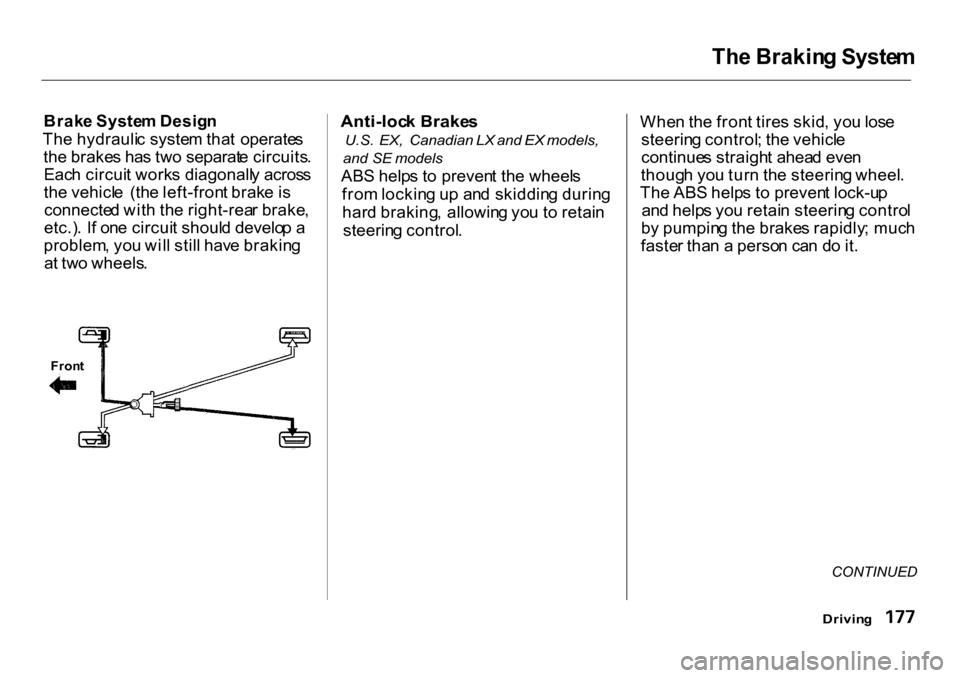
Th
e Brakin g Syste m
Brak e Syste m Desig n
Th e hydrauli c syste m tha t operate s
th e brake s ha s tw o separat e circuits .
Eac h circui t work s diagonall y acros s
th e vehicl e (th e left-fron t brak e is
connecte d wit h th e right-rea r brake ,
etc.) . I f on e circui t shoul d develo p a
problem , yo u wil l stil l hav e brakin g
a t tw o wheels .
Anti-loc
k Brake s
U.S. EX, Canadian LX and EX models,
and SE models
AB S help s t o preven t th e wheel s
fro m lockin g u p an d skiddin g durin g
har d braking , allowin g yo u t o retai n
steerin g control . Whe
n th e fron t tire s skid , yo u los e
steerin g control ; th e vehicl e
continue s straigh t ahea d eve n
thoug h yo u tur n th e steerin g wheel .
Th e AB S help s t o preven t lock-u p
an d help s yo u retai n steerin g contro l
b y pumpin g th e brake s rapidly ; muc h
faste r tha n a perso n ca n d o it .
CONTINUED
Drivin g
Fron
t
Page 185 of 326
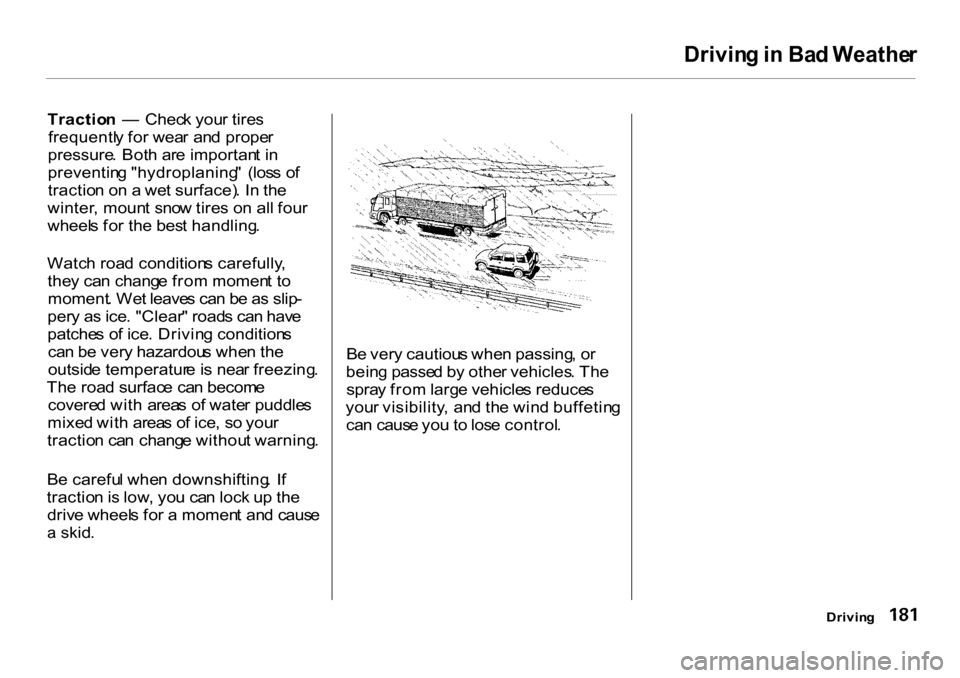
Drivin
g in Ba d Weathe r
Tractio n — Chec k you r tire s
frequentl y fo r wea r an d prope r
pressure . Bot h ar e importan t i n
preventin g "hydroplaning " (los s o f
tractio n o n a we t surface) . I n th e
winter , moun t sno w tire s o n al l fou r
wheel s fo r the bes t handling .
Watc h roa d condition s carefully ,
the y ca n chang e fro m momen t t o
moment . We t leave s ca n b e a s slip -
per y a s ice . "Clear " road s ca n hav e
patche s o f ice . Drivin g condition s
ca n b e ver y hazardou s whe n th e
outsid e temperatur e is nea r freezing .
Th e roa d surfac e ca n becom e
covere d wit h area s o f wate r puddle s
mixe d wit h area s o f ice , s o you r
tractio n ca n chang e withou t warning .
B e carefu l whe n downshifting . I f
tractio n is low , yo u ca n loc k u p th e
driv e wheel s fo r a momen t an d caus e
a skid .
B
e ver y cautiou s whe n passing , o r
bein g passe d b y othe r vehicles . Th e
spra y fro m larg e vehicle s reduce s
you r visibility , an d th e win d buffetin g
ca n caus e yo u to los e control .
Driving
Page 192 of 326
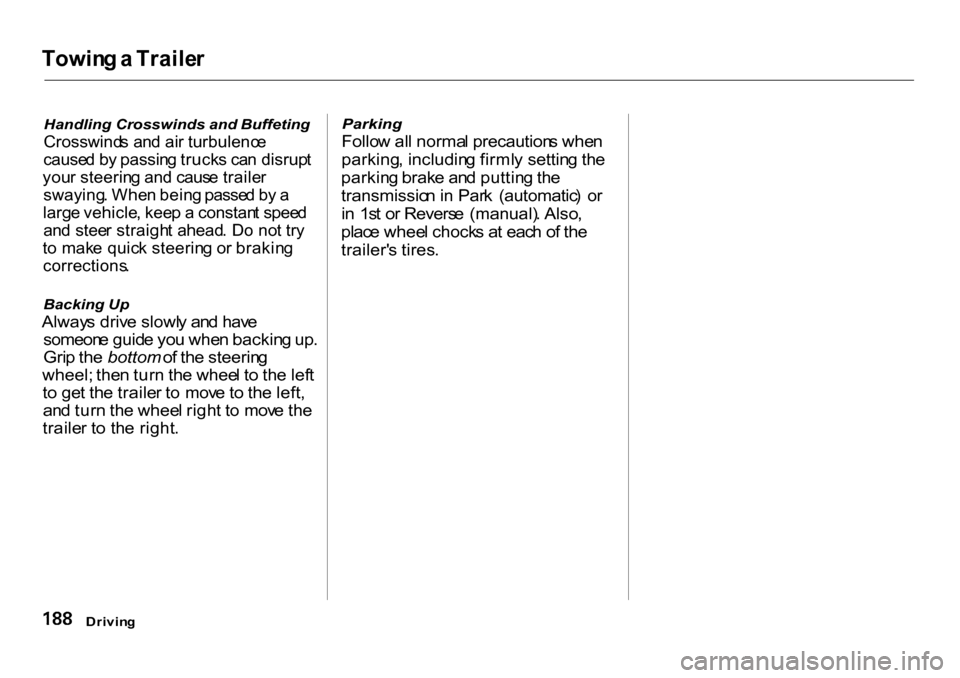
Towin
g a Traile r
Handling Crosswinds and Buffeting
Crosswind s an d ai r turbulenc e
cause d b y passin g truck s ca n disrup t
you r steerin g an d caus e traile r
swaying . Whe n bein g passe d b y a
larg e vehicle , kee p a constan t spee d
an d stee r straigh t ahead . D o no t tr y
t o mak e quic k steerin g o r brakin g
corrections .
Backing Up
Alway s driv e slowl y an d hav e
someon e guid e yo u whe n backin g up .
Gri p th e bottom of th e steerin g
wheel; then tur n th e whee l t o th e lef t
t o ge t th e traile r t o mov e to th e left ,
an d tur n th e whee l righ t t o mov e th e
traile r t o th e right .
Parking
Follo w al l norma l precaution s whe n
parking , includin g firml y settin g th e
parkin g brak e an d puttin g th e
transmissio n in Par k (automatic ) o r
i n 1s t o r Revers e (manual) . Also ,
plac e whee l chock s a t eac h o f th e
trailer' s tires .
Drivin g
Page 193 of 326

Towin
g You r Vehicl e Behin d a Motorhom e
You r CR- V ca n b e towe d behin d a
motorhom e a t lega l highwa y speed s
u p to 6 5 mp h (10 0 km/h) . T o avoi d
damag e t o th e 4W D syste m it mus t
b e "fla t towed " wit h al l fou r wheel s
o n th e ground .
Whe n purchasin g a to w bar , mak e
sur e yo u selec t a reputabl e
manufacture r an d installer . Follo w
th e manufacturer' s attachmen t
instruction s carefully .
Afte r attachin g th e to w ba r t o you r
motorhome , d o th e followin g to
prepar e you r CR- V fo r "fla t towing" :
5-speed
Manual Transmission
Whe
n preparin g to to w you r CR-V ,
mak e sur e th e transmissio n is
fille d to th e correc t leve l (se e pag e
222 ). D o no t overfill . Releas
e th e parkin g brake . Shif
t th e transmissio n t o Neutral .
Leav
e th e ke y in th e ignitio n
switc h an d th e ignitio n switc h in
ACCESSOR Y (I ) s o th e steerin g
whee l doe s no t lock . Mak e sur e
th e radi o an d an y item s plugge d
int o th e accessor y powe r socket s
ar e turne d of f s o yo u d o no t ru n
dow n th e battery .
Automatic
Transmission
Whe n preparin g t o to w you r CR-V ,
mak e sur e th e transmissio n i s ful l o f
fluid . Maintainin g th e correc t leve l i s
ver y important . D o no t overfill . D o
th e followin g every day immediately
before you begin towing. Follow th e
procedur e exactly . Otherwise , sever e
automati c transmissio n damag e wil l
occur .
CONTINUED
Drivin g
Page 194 of 326
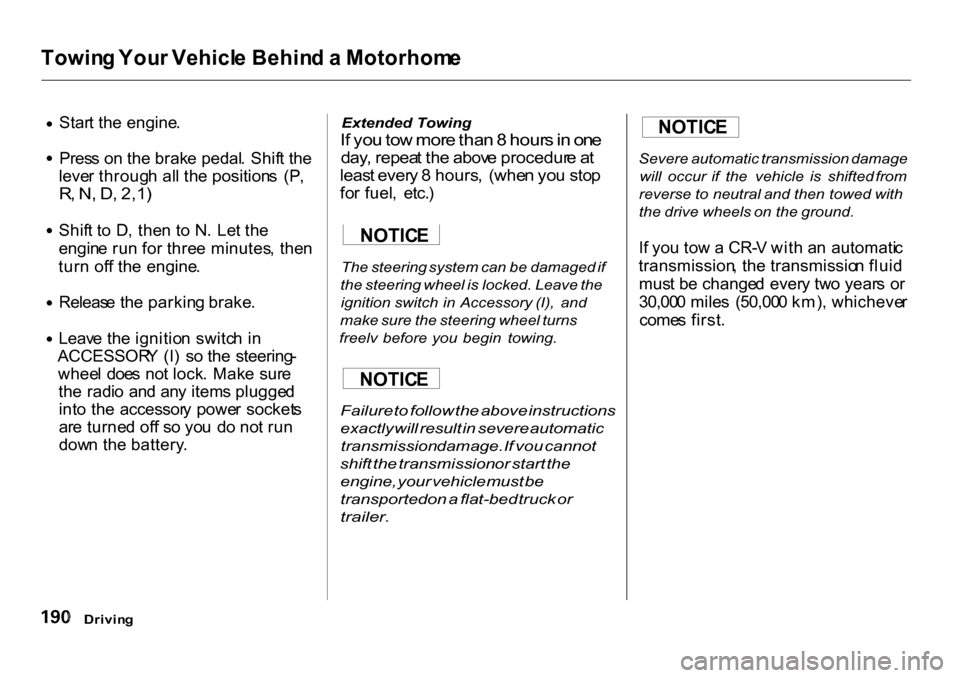
Towin
g You r Vehicl e Behin d a Motorhom e
Star
t th e engine .
Pres s o n th e brak e pedal . Shif t th e
leve r throug h al l th e position s (P ,
R , N , D , 2,1 )
Shif t t o D , the n t o N . Le t th e
engin e ru n fo r thre e minutes , the n
tur n of f th e engine .
Releas e th e parkin g brake .
Leav e th e ignitio n switc h i n
ACCESSOR Y (I ) s o th e steering -
whee l doe s no t lock . Mak e sur e
th e radi o an d an y item s plugge d
int o th e accessor y powe r socket s
ar e turne d of f s o yo u d o no t ru n
dow n th e battery .
Extended
Towing
I f yo u to w mor e tha n 8 hour s in on e
day , repea t th e abov e procedur e a t
leas t ever y 8 hours , (whe n yo u sto p
fo r fuel , etc. )
The steering system can be damaged if
the steering wheel is locked. Leave the
ignition switch in Accessory (I), and
make sure the steering wheel turns
freelv before you begin towing.
Failure to follow the above instructions
exactly will result in severe automatic
transmission damage. If vou cannot
shift the transmission or start the
engine, your vehicle must be
transported on a flat-bed truck or
trailer.
Severe
automatic transmission damage
will occur if the vehicle is shifted from
reverse to neutral and then towed with
the drive wheels on the ground.
I f yo u to w a CR- V wit h a n automati c
transmission , th e transmissio n flui d
mus t b e change d ever y tw o year s o r
30,00 0 mile s (50,00 0 km) , whicheve r
come s first .
Drivin g
NOTIC
E
NOTIC E NOTIC
E
Page 199 of 326
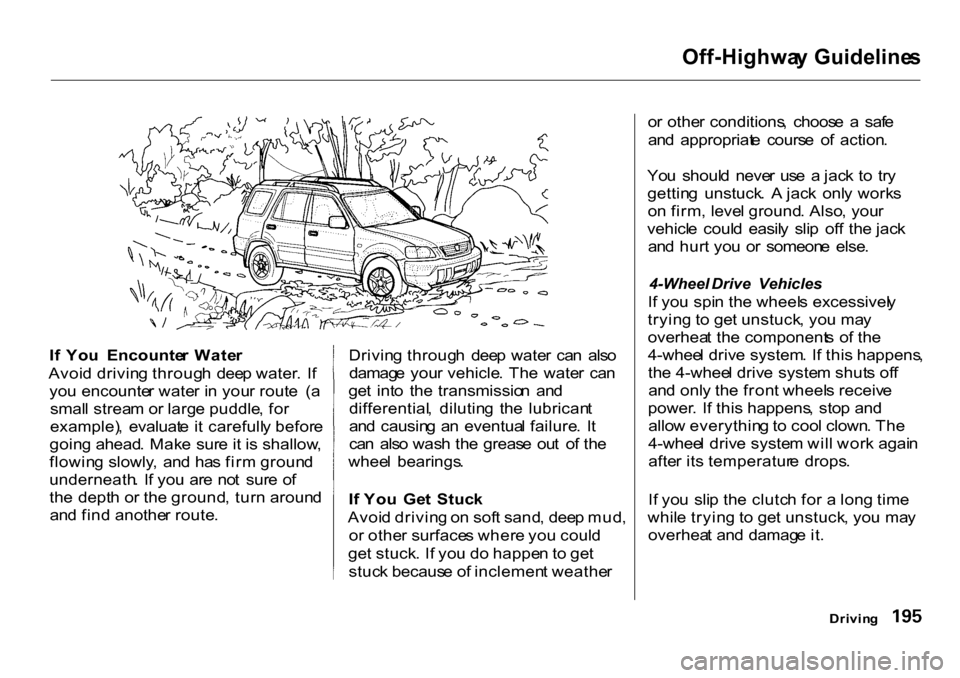
Off-Highwa
y Guideline s
I f Yo u Encounte r Wate r
Avoi d drivin g throug h dee p water . I f
yo u encounte r wate r i n you r rout e ( a
smal l strea m o r larg e puddle , fo r
example) , evaluat e i t carefull y befor e
goin g ahead . Mak e sur e it i s shallow ,
flowin g slowly , an d ha s fir m groun d
underneath . I f yo u ar e no t sur e o f
th e dept h o r th e ground , tur n aroun d
an d fin d anothe r route . Drivin
g throug h dee p wate r ca n als o
damag e you r vehicle . Th e wate r ca n
ge t int o the transmissio n an d
differential , dilutin g th e lubrican t
an d causin g a n eventua l failure . I t
ca n als o was h th e greas e ou t o f th e
whee l bearings .
I f Yo u Ge t Stuc k
Avoi d drivin g o n sof t sand , dee p mud ,
o r othe r surface s wher e yo u coul d
ge t stuck . I f yo u d o happe n to ge t
stuc k becaus e o f inclemen t weathe ro
r othe r conditions , choos e a saf e
an d appropriat e cours e o f action .
Yo u shoul d neve r us e a jac k t o tr y
gettin g unstuck . A jac k onl y work s
o n firm , leve l ground . Also , you r
vehicl e coul d easil y sli p of f th e jac k
an d hur t yo u o r someon e else .
4-Wheel Drive Vehicles
I f yo u spi n th e wheel s excessivel y
tryin g t o ge t unstuck , yo u ma y
overhea t th e component s o f th e
4-whee l driv e system . I f thi s happens ,
th e 4-whee l driv e syste m shut s of f
an d onl y th e fron t wheel s receiv e
power . I f thi s happens , sto p an d
allo w everythin g to coo l clown . Th e
4-whee l driv e syste m wil l wor k agai n
afte r it s temperatur e drops .
I f yo u sli p th e clutc h fo r a lon g tim e
whil e tryin g t o ge t unstuck , yo u ma y
overhea t an d damag e it .
Drivin g
Page 201 of 326
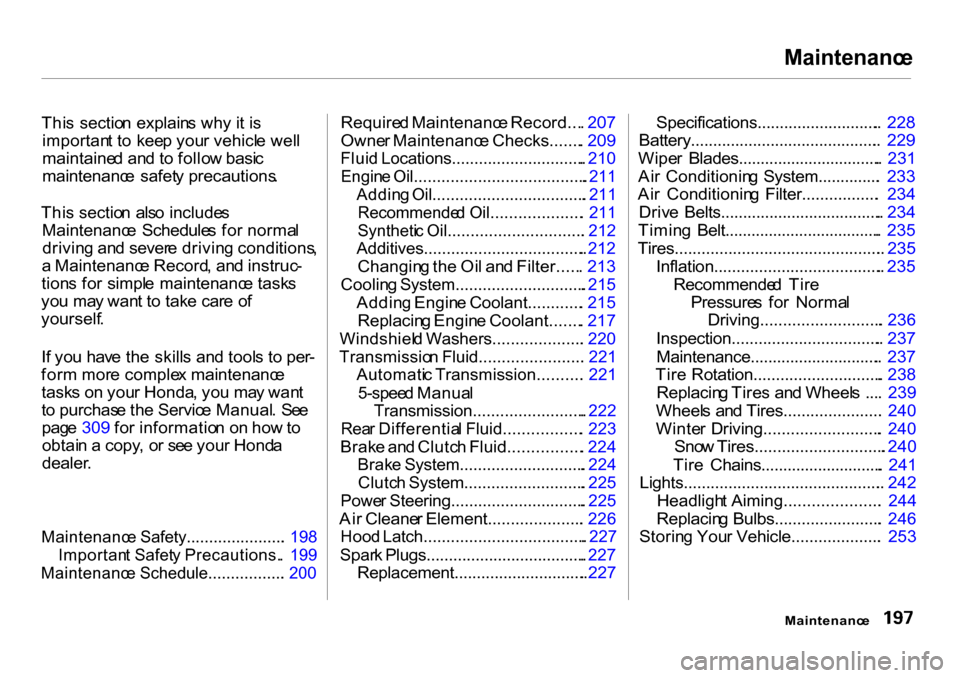
Maintenanc
e
Thi s sectio n explain s wh y i t i s
importan t t o kee p you r vehicl e wel l
maintaine d an d t o follo w basi c
maintenanc e safet y precautions .
Thi s sectio n als o include s
Maintenanc e Schedule s fo r norma l
drivin g an d sever e drivin g conditions ,
a Maintenanc e Record , an d instruc -
tion s fo r simpl e maintenanc e task s
yo u ma y wan t t o tak e car e o f
yourself .
I f yo u hav e th e skill s an d tool s t o per -
for m mor e comple x maintenanc e
task s o n you r Honda , yo u ma y wan t
t o purchas e th e Servic e Manual . Se e
pag e 309 for informatio n o n ho w to
obtai n a copy , o r se e you r Hond a
dealer .
Maintenanc e Safety...................... . 198
Importan t Safet y Precautions. . 199
Maintenanc e Schedule................. . 200
Require
d Maintenanc e Record... . 207
Owne r Maintenanc e Checks....... . 209
Flui d Locations.............................. . 210
Engin e Oil...................................... . 211
Addin g Oil.................................. . 211
Recommende d Oil.................... . 211
Syntheti c Oil.............................. . 212
Additives.................................... . 212
Changin g th e Oi l an d Filter..... . 213
Coolin g System............................. . 215
Addin g Engin e Coolant............ . 215
Replacin g Engin e Coolant....... . 217
Windshiel d Washers.................... . 220
Transmissio n Fluid....................... . 221
Automati c Transmission.......... . 221
5-spee d Manua l
Transmission......................... . 222
Rea r Differentia l Fluid................. . 223
Brak e an d Clutc h Fluid................ . 224
Brak e System............................ . 224
Clutc h System........................... . 225
Powe r Steering.............................. . 225
Ai r Cleane r Element..................... . 226
Hoo d Latch.................................... . 227
Spar k Plugs.................................... . 227
Replacement.............................. . 227
Specifications............................
. 228
Battery........................................... . 229
Wipe r Blades................................. . 231
Ai r Conditionin g System.............. . 233
Ai r Conditionin g Filter................. . 234
Driv e Belts..................................... . 234
Timin g Belt.................................... . 235
Tires............................................... . 235
Inflation...................................... . 235
Recommende d Tir e
Pressure s fo r Norma l
Driving........................... . 236
Inspection.................................. . 237
Maintenance.............................. . 237
Tir e Rotation............................. . 238
Replacin g Tire s an d Wheel s ... . 239
Wheel s an d Tires...................... . 240
Winte r Driving.......................... . 240
Sno w Tires............................. . 240
Tir e Chains............................ . 241
Lights............................................. . 242
Headligh t Aiming..................... . 244
Replacin g Bulbs........................ . 246
Storin g You r Vehicle.................... . 253
Maintenanc e
Page 229 of 326
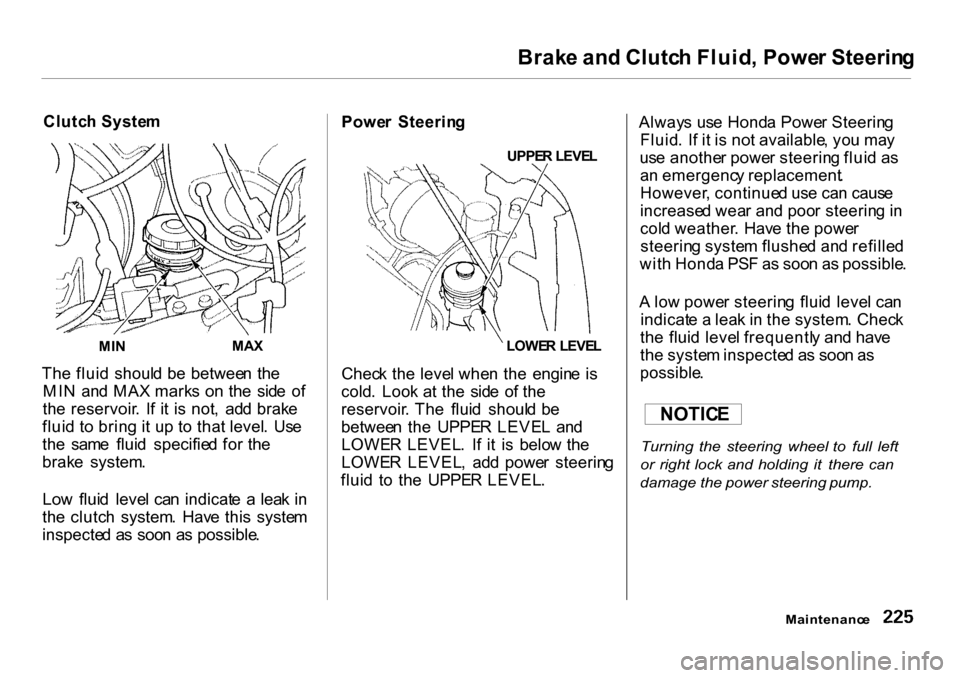
Brak
e an d Clutc h Fluid , Powe r Steerin g
Clutc h Syste m
MI N MA
X
Th e flui d shoul d b e betwee n th e
MI N an d MA X mark s o n th e sid e o f
th e reservoir . I f i t i s not , ad d brak e
flui d t o brin g i t u p t o tha t level . Us e
th e sam e flui d specifie d fo r th e
brak e system .
Lo w flui d leve l ca n indicat e a lea k i n
th e clutc h system . Hav e thi s syste m
inspecte d a s soo n a s possible . Powe
r Steerin g
UPPER LEVE L
LOWE R LEVE L
Chec k th e leve l whe n th e engin e i s
cold . Loo k a t th e sid e o f th e
reservoir . Th e flui d shoul d b e
betwee n th e UPPE R LEVE L an d
LOWE R LEVEL . I f i t i s belo w th e
LOWE R LEVEL , ad d powe r steerin g
flui d t o th e UPPE R LEVEL . Alway
s us e Hond a Powe r Steerin g
Fluid . I f i t i s no t available , yo u ma y
us e anothe r powe r steerin g flui d a s
a n emergenc y replacement .
However , continue d us e ca n caus e
increase d wea r an d poo r steerin g in
col d weather . Hav e th e powe r
steerin g syste m flushe d an d refille d
wit h Hond a PS F a s soo n a s possible .
A lo w powe r steerin g flui d leve l ca n
indicat e a lea k i n th e system . Chec k
th e flui d leve l frequentl y an d hav e
th e syste m inspecte d a s soo n a s
possible .
Turning the steering wheel to full left
or right lock and holding it there can
damage the power steering pump.
Maintenanc e
NOTIC
E